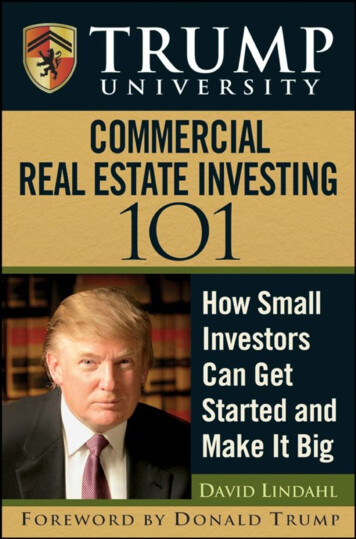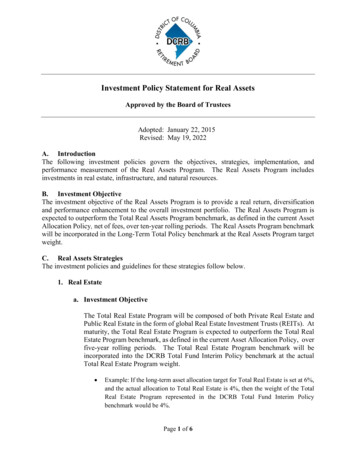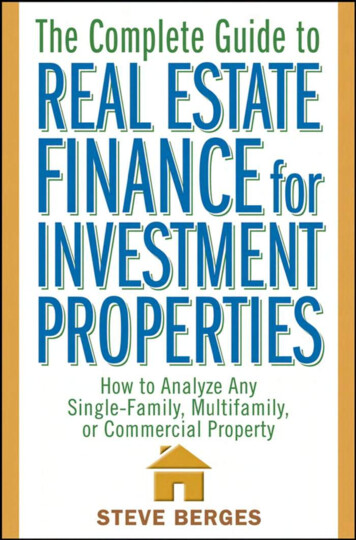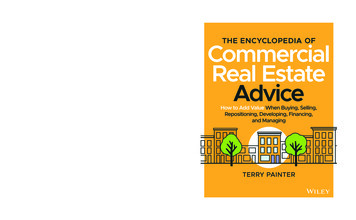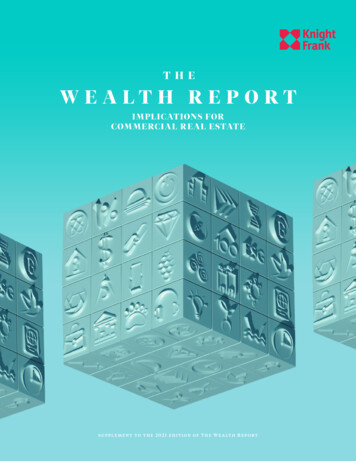
Transcription
I M PLICATIONS FORCOM M ERCI A L R E A L E STATEs u p p l e m e n t t o t h e 2 0 2 1 e d i t i o n o f T h e W e a lt h R e p o rt
T H E W E A LT H R E P O R T 2 0 2 1 - I M P L I C A T I O N S F O R C O M M E R C I A L R E A L E S T A T EP1IntroductionFor 15 years, The Wealth Report has documented the riseof private investors and their attitudes towards investing inreal estate. Over this time, interest in commercial assetshas grown substantially. Our latest global Attitudes Surveyresults show that private investors have, on average,allocated 21% of their portfolios to investment property and that theyintend this figure to rise throughout 2021.Whether directly or indirectly, private investors accounted for32% of the 720bn spent on commercial real estate globally in 2020.Acquisitions have grown in scale and strategies have become evermore sophisticated, providing real competition to institutional investors,property companies and REITs. Appreciating the significance andimplications of this growing source of capital is vital to anyone seekingto understand future trends in global real estate investment.Meet theauthorsThe contributors toThe Wealth Report : Implicationsfor Commercial Real EstateW I L L I A M M AT T H E W SWill heads up our UK commercialThe Wealth Reportresearch division with a teamfocusing on developing marketleading insight.The Wealth Report is Knight Frank’sflagship annual publication, offering aunique perspective on global wealth, primeproperty and investment. Now in its 15thedition, this year’s Report provides adetailed analysis on how Covid-19 hasimpacted economic performance, wealthcreation and asset classes around theglobe, as well as our forecast forcommercial and residential real estate theworld over.william.matthews@knightfrank.comF LO RA HA R L E YFlora is Deputy Editor of The WealthReport and, with a passion foreconomics, curates the Wealth andCities sections.t h e g l o b a l p e r s p e c t i v e o n p r i m e p ro p e rt y & i n v e s t m e n t2021 — 15TH EDITIONflora.harley@knightfrank.com
T H E W E A LT H R E P O R T 2 0 2 1 - I M P L I C A T I O N S F O R C O M M E R C I A L R E A L E S T A T EP2Private wealthRESILIENCEAND GROWTHThe number of UHNWIsgrew despite thepandemicChange in UHNWI population in 2020Additional UHNWIs by countryKnight Frank’s Wealth SizingModel reveals that, globally, the number ofUHNWIs (ultra-high net-worth individuals)grew by 2.4% in 2020 to more than 520,000.While this was roughly one-third the rateof growth seen in 2019, it is a far strongerexpansion than we would have predicted inthe first half of the year, given the impact ofCovid-19.The model’s results reflect the views ofthe respondents (leading private bankers andwealth advisors) to our latest Attitudes Survey,undertaken during Q4 2020.Half said their clients’ wealth hadincreased in the last year. Those with NorthAmerican clients were the most optimistic,with 73% citing an increase and a further23% seeing stability. The region’s UHNWIpopulation now sits at 190,085, almost 4%higher than at the end of 2019. The regionswhich were seemingly able to control thevirus the best, Asia and Australasia, were thestrongest performers with growth of 12% and10% respectively.Three key drivers of rising wealthAmong those survey respondentswho said their UHNWI clients’ wealth hadincreased, three key themes emerged as towhy: diversification, equities and property.1The benefits ofdiversified portfoliosDiversified portfolios with long-terminvestment strategies, which follow trendssuch as the rise of technology, allowed lossesin some areas to be offset by growth in others.Whether across asset classes or geographies,if done correctly this seemed to help many toweather the storm.9,594China6,080United audi Arabia617Sweden531South Korea436Singapore345Source: Knight Frank Wealth Sizing Model2Riding theequity rallyGiven that the Attitudes Survey showsequities account for nearly a quarter ofUHNWI wealth portfolios, it is unsurprisingthat this was a major driver of wealth growthin certain countries. After most stock marketscrashed by around 30% in March, as the trueextent of Covid-19 became apparent, there hasbeen a remarkable bounce back, particularlyin the US where the S&P rallied by almost 70%.3Resilientproperty portfoliosAs the largest single element in the averageUHNWI investment portfolio – according tothe Attitudes Survey – property values andholdings (both residential and commercial)play a significant role in total wealth levels. Somesurvey respondents believed that the capitalvalue of their clients’ holdings had fallen, butthe general message was one of resilience.
T H E W E A LT H R E P O R T 2 0 2 1 - I M P L I C A T I O N S F O R C O M M E R C I A L R E A L E S T A T EP3The outlook forPRIVATE WEALTHForecast regional UHNWI populations in 2025and countries with highest five-year growthAbsolute number of UHNWIsCountries with strongest growth within Canada23%Russia&CIS1 3 ,0 9 7Kazakhstan 33%29%RussiaAsiaOur model predicts that theglobal population of UHNWIswill grow by 27% over the nextfive years, while the number ofHNWIs – or millionaires – isforecast to rise by 41%. Respondents to ourAttitudes Survey also take an optimistic view,with 93% expecting their clients’ wealth to staythe same or increase in 2021. Just over onefifth of these expect a significant – above 10% –increase. Those in North America, Australasiaand Asia are the most optimistic, with 86%,82% and 81% predicting either an increase ora significant increase.Asia tops our five-year UHNWI growthforecast with 39%, led by Indonesia on 67%and India on 63%. This would see Asia’sproportion of global UHNWIs rise from 22% to24%. Europe will retain its crown as the secondlargest wealth hub with expected growth of23%, bringing the total number of UHNWIs to189,546. The biggest rises are forecast in Polandwith 61%, and Sweden with 59%.Indonesia67%India63%185,860236, 297161,878Africa4,361Zambia40%South Africa 32%Australasia6,689Latin America1 8,0 6 0Source: Knight Frank Wealth Sizing ModelMexico26%Brazil23%New Zealand52%Australia20%Middle East3 7, 2 4 1Turkey43%UAE22%
T H E W E A LT H R E P O R T 2 0 2 1 - I M P L I C A T I O N S F O R C O M M E R C I A L R E A L E S T A T EP4The outlook forPRIVATE WEALTHComing out of the crisis –the biggest issues affecting wealthWhen we asked Attitudes Surveyrespondents about the issues that were ofgreatest concern to their clients, Covid-19unsurprisingly came out on top, with 80%choosing it as a key risk. But nearly 90%see new investment opportunities in a postpandemic world. The availability and greateradoption of technology will aid this, and justunder half of our survey respondents findtechnology as a disruptor exciting.The arc of global geopolitics will alwaysplay a huge role in wealth creation. In lastyear’s Attitudes Survey political tensions andtrade wars was the second most cited concern– this year, it has slipped to fourth place.As we move on from 2020, therefore,private investors are optimistic aboutinvestment opportunities, increasinglyfocused on technology, and somewhat lessconcerned by geopolitical tensions.Wealth opportunitiesThe opportunities most likelyto excite UHNWIs in 202187%New investment opportunitiesin a post-pandemic world6%47%BrexitTechnologicaldisruption asan 2%Opportunitiesarising from theESG agendaSource: The Wealth Report Attitudes SurveyWealth transfer tothe next generation25%Domestic government policy
T H E W E A LT H R E P O R T 2 0 2 1 - I M P L I C A T I O N S F O R C O M M E R C I A L R E A L E S T A T EP5The importance ofprivate capitalIN GLOBAL REALESTATE INVESTMENTPrivate investors have a long history of deploying capital in commercial real estate, but as thechart shows, the scale of this activity has increased markedly in recent years. Private capital,in various guises, routinely accounts for a third of global investment in commercial real estatePrivate capital investment by yearPrivate capital investment ( 0Sources: Knight Frank/RCATransaction volumes were down last yearacross the globe with private capital notimmune. However private buying activitywas 9% up on the 10-year average and farstronger than the 6% fall in the amountcommitted by institutional investors.Looking ahead, our research suggests that privateinvestment in commercial real estate will rebound sharplyin 2021. One reason for this is that current portfolioallocations to commercial real estate, while not lowcompared with institutional allocations, still shows room forgrowth in many regions, including Asia, Russia & CIS, andthe UK. Globally, the share of respondents expecting clientsto invest in commercial real estate this year edged up to25%, from just over 20% in the year prior. Although currentrestrictions on movement point to a focus on domestic dealsinitially, we expect a strong level of international purchasesto be resumed with the lifting of domestic and internationaltravel restrictions.
T H E W E A LT H R E P O R T 2 0 2 1 - I M P L I C A T I O N S F O R C O M M E R C I A L R E A L E S T A T EP6The importance of private capitalIN GLOBAL REAL ESTATE INVESTMENTWhat will this investment look like? Current allocations tocommercial real estate favour the private rented residentialsector and offices, but in addition to these, interest inlogistics and industrial property, development land, andhealthcare and retirement living also features prominently.Allocations to commercial propertyResponses from our Attitudes SurveyWhat proportion of your clients' wealth is directlyallocated to commercial %Europe (excl UK)29%22%Latin AmericaMiddle East23%23%23%30%20%North AmericaRussia & CIS16%UK16%Regional AverageWhat % of your clients are planning toinvest in commercial property in 2021?21%27%21%25%Source: The Wealth Report Attitudes SurveySector focusWhich of these sectors are becomingof more interest to your clients?2020 Attitudes Survey1.Offices2021 Attitudes Survey1.Residential private rented sector (PRS)2. Healthcare2. Logistics3. Development land3. Development land4. Hotels and leisure4. Offices5. Retirement5. Industrial6. Logistics6. Healthcare7.7.Residential private rented sector (PRS)Retirement8. Infrastructure8. Hotels and leisure9. Student housing9. Agricultural10. Industrial10. Infrastructure11. Education11. Data centres12. Retail12. Retail13. Agricultural13. Student housing14. Data centres14. EducationSource: The Wealth Report Attitudes Survey
T H E W E A LT H R E P O R T 2 0 2 1 - I M P L I C A T I O N S F O R C O M M E R C I A L R E A L E S T A T EP7The importance of private capitalIN GLOBAL REAL ESTATE INVESTMENTThree investment themes for 2021In addition to the preferred sector allocations identifiedby our research, we predict that private investment overthe coming year will converge around three morefundamental themes: a renewed focus on domestic andnear-neighbour locations, more overt targeting ofsustainable assets and implementation of ESG strategies,and the hunt for assets, sectors and locations ridingthe wave of premium performance driven by the keypandemic megatrends.Near-neighbour safe havensLarge, liquid transparent markets with favourablestructures and legal systems will continue to be a bigdraw for investors across all capital types. The globalSuper Cities will remain key picks and increased politicalcertainty in regions such as the US and Europe will addfurther conviction to these core markets.As The Wealth Report data highlights, there will continueto be severe disruption in global travel in 2021, with 84%of respondents expecting to continue to travel less thisyear. In our view this means there is a real opportunity forprivate buyers to capture rarefied assets in their homemarkets or those locations that they have builtappropriate specialist resource. We see a rare opportunity for private capital to access locations and stockthat would normally face intense competition from amuch larger pool of global investors.ESG: SustainabilityOur Attitudes Survey data reveals a rapidly growinginterest in ESG: nearly half of all family offices are nowmore interested in ESG-focussed investments than theywere 12 months ago; for all UHNWIs this rises to as muchas 65% for North America, 60% in Australasia and 51%in the UK. The pandemic has accelerated rather thandampened interest in this critical theme.Understandably, there remains a desire to amass moreknowledge in what can be a complex, technical field.Less than a quarter of investors in Asia and the MiddleEast felt that they had all the information required tomake ESG investments. Just over half of investorsin Europe felt equipped to make such investments, whilethe figure was highest in the US, at 70%.Ultimately, however, we believe that private investors willbe well positioned to capture the 'green premium' weexpect to see for the limited number of assets thatconform to rapidly growing institutional requirement forsustainable real estate. As demand for these assetsbuilds, the premium will undoubtedly emerge. Buyingbest-in-class assets or transforming existing buildings tomeet current sustainability criteria will be an extremelyimportant focus this year.Pandemic premiumsThe pandemic has seen the emergence of a K-shapedrecovery - accelerated tech adoption and ways ofworking have supercharged some sectors while shrinkingothers. Areas such as pharmaceuticals, e-commerce,tech manufacturing, renewables, digital entertainmentand data storage have surged.Consequently, real estate sectors such as data centres,logistics, film studios and life sciences will continue tobenefit from these trends and will see strong occupierand investor demand. Real estate including offices,residential and retail in locations where innovation inthese sectors dominate will also be a key pick.With our Attitudes Survey results showing that interest incommercial property is spread across a much broaderrange of property types than in previous years, there isevidence that private investors are already starting totake these emerging themes into consideration.
T H E W E A LT H R E P O R T 2 0 2 1 - I M P L I C A T I O N S F O R C O M M E R C I A L R E A L E S T A T EP8KeyCOMMERCIALDEALSA selection of transactions from across the Knight Frank networkthat helped define the private investment market in 202050 Flinders StreetOntime Urban Distribution Unit105 KeizersgrachtLocationAdelaide, AustraliaLocationMadrid, SpainLocationAmsterdam, NetherlandsPurchaserNikos Property gisticsSectorOfficeSq ft231,426 sq ftSq ft188,089 sq ftSq ft25,533 sq ftPriceAU 175,000,000Price 21,700,000Price 31,100,000
K N I G H T F R A N K .C O M / W E A LT H R E P O RTImportant notice 2021. All rights reserved.This publication is produced for general outline information only, it is not definitive and it is not to be relied upon in any way. Although we believe that high standards have been used in the preparation of the information, analysis and viewspresented, no responsibility or liability whatsoever can be accepted by Knight Frank for any errors or loss or damage resultant from the use of or reference to the contents of this publication. We make no express or implied warranty or guarantee ofthe accuracy of any of the contents. This publication does not necessarily reflect the view of Knight Frank in any respect. Information may have been provided by others without verification. Readers should not take or omit to take any action as aresult of information in this publication.In preparing this publication, Knight Frank does not imply or establish any client, advisory, financial or professional relationship, nor is Knight Frank or any other person providing advisory, financial or other services. In particular, Knight FrankLLP is not authorised by the Financial Conduct Authority to undertake regulated activities (other than limited insurance intermediation activity in connection with property management).No part of this publication shall be reproduced, stored in a retrieval system, or transmitted in any form or by any means, electronic, mechanical, photocopying, recording or otherwise, without prior written permission from Knight Frank for the same,including, in the case of reproduction, prior written approval of Knight Frank to the specific form and content within which it appears.Knight Frank LLP is a member of an international network of independent firms which may use the “Knight Frank” name and/or logos as all or part of their business names. No “Knight Frank” entity acts as agent for, or has any authority torepresent, bind or obligate in any way, any other “Knight Frank” entity. This publication is compiled from information contributed by various sources including Knight Frank LLP, its direct UK subsidiaries and a network of separate and independentoverseas entities or practices offering property services. Together these are generally known as “the Knight Frank global network”. Each entity or practice in the Knight Frank global network is a distinct and separate legal entity. Its ownership andmanagement is distinct from that of any other entity or practice, whether operating under the name Knight Frank or otherwise. Where applicable, references to Knight Frank include the Knight Frank global network. Knight Frank LLP is a limitedliability partnership registered in England with registered number OC305934, the registered office is 55 Baker Street London W1U 8AN, where a list of members’ names may be inspected.The Wealth Report contains numerous articles that provide information on everything from wealth populations to property price changes and philanthropic endeavours. The vast majority of these articles are independently curated. Occasionally,however, we create one-off articles in collaboration with a partner that we term “Partnership Content”. Any content that is created as part of a partnership where the partner has compensated us or contributed to the cost of creating the article isalways clearly labelled as “Partnership Content”. When an article is funded, whether in whole or in part, by a partner, Knight Frank maintains editorial control over such content and all Partnership Content is written in-house by our editorial team.
IN GLOBAL REAL ESTATE INVESTMENT Private investors have a long history of deploying capital in commercial real estate, but as the chart shows, the scale of this activity has increased markedly in recent years. Private capital, in various guises, routinely accounts for a third of global investment in commercial real estate 98.1 126.2 154.3 187.2 .
